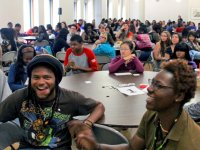Turning Classes Into Communities
By intentionally building community, respecting students’ human needs, and modeling what we value, we help students experience school as a place of belonging and transformation.
Your content has been saved!
Go to My Saved Content.Grace Lee Boggs, activist, philosopher, and visionary, passed away in October at the age of 100. Boggs was deeply inspired and informed by Martin Luther King Jr.’s idea of The Beloved Community. In The Next American Revolution, she wrote:
We urgently need to bring to our communities the limitless capacity to love, serve, and create for and with each other. We urgently need to bring the neighbor back into our hoods, not only in our inner cities but also in our suburbs, our gated communities, on Main Street and Wall Street, and on Ivy League campuses.
A Place of Connection
The sad truth is that there is very little about the traditional structure of school that encourages people to build communities that love, serve, and create. Most of us spend our school days racing from one task to another, preparing for the next class, trying to grade and return work to students in a reasonable amount of time, and dealing with the many crises and unexpected situations that develop during the course of any normal school day. It's exhilarating and stimulating but does not promote connection or community.
Meanwhile, secondary students move according to the clock, required to rush from one room to another with little control over their time or their tasks. They snatch morsels of time to socialize with their peers and are continually reorienting to new settings throughout the day.
I present this dismal portrait of school as a reminder of the importance of relationships, human-centered experiences, and community. If all that I had to look forward to every workday was a series of tasks, my work would quickly lose meaning and become a sterile routine. The same is of course true for students who lack control and power in determining their own realities and schedules. Although it is obvious, it is also important to remind ourselves that young people share basic human desires to recognized, seen, and heard.
Despite all the obstacles and challenges, school can -- and should -- be a place of connection, relationships, and caring. It is possible for us to recognize one another's entirety and create environments where there is a shared ethos of loving, serving, and creating. By working to turn classes into communities, school becomes more than a series of tasks and is instead a place where people feel a sense of belonging, value, and inspiration.
5 Steps Toward Building Community
There are numerous practices that help establish and maintain classroom communities. I've listed some below and would love for readers to share additional ideas in the comments.
Give students opportunities to share multiple parts of their lives.
Student choice, diverse curriculum, and prioritizing student voices are all ways that students can find opportunities to tell and reflect upon stories that matter to them. School is of course about work, but it should also be about who we are.
Acknowledge what's good.
I am so often focused on what I want my students to achieve and on how they and I can improve what we're doing that I sometimes forget to acknowledge amazing things that are happening right in front of me. Everyone gains from public acknowledgement of what's going well, high-quality work produced, and insightful comments made.
Provide time for collaboration and student-to-student interaction.
Communities thrive when people have a voice and when they're given opportunities to communicate with others. When work is a collaborative endeavor (even if the final product is individual), there are opportunities to connect with and learn from others. Sherry Turkle's writing is a thoughtful reminder about the value of face-to-face conversation in the lives of teens.
Check in and monitor the lives of groups.
There are many times when students need to be heard. At times they need to express their ideas or struggles with schoolwork. At other times, they need opportunities to speak about other issues in their lives or with their peers. Creating timely opportunities for students to be heard and for groups to work through issues and conflicts helps to create community.
Be the host and set the tone.
Even on days when I've had to race to school after a chaotic morning at home and feel like less than my best self, my students deserve to feel welcomed and valued. The more kindness, warmth, and compassion that I convey, the more students will learn, grow, and connect. I want my students to know when I feel that they've fallen short or can do better, but I strive to make sure that these challenges come in the context of support and belief in their abilities.
Love, Serve, Create
Our schools continue in their struggle to move beyond a traditional model of education where students' lived realities were often ignored. Intentionally building community, respecting students' human needs, and modeling what we value are practices that allow students to experience school as a place of belonging and transformation. Love, serve, and create. Grace Lee Boggs couldn't have been more right.
